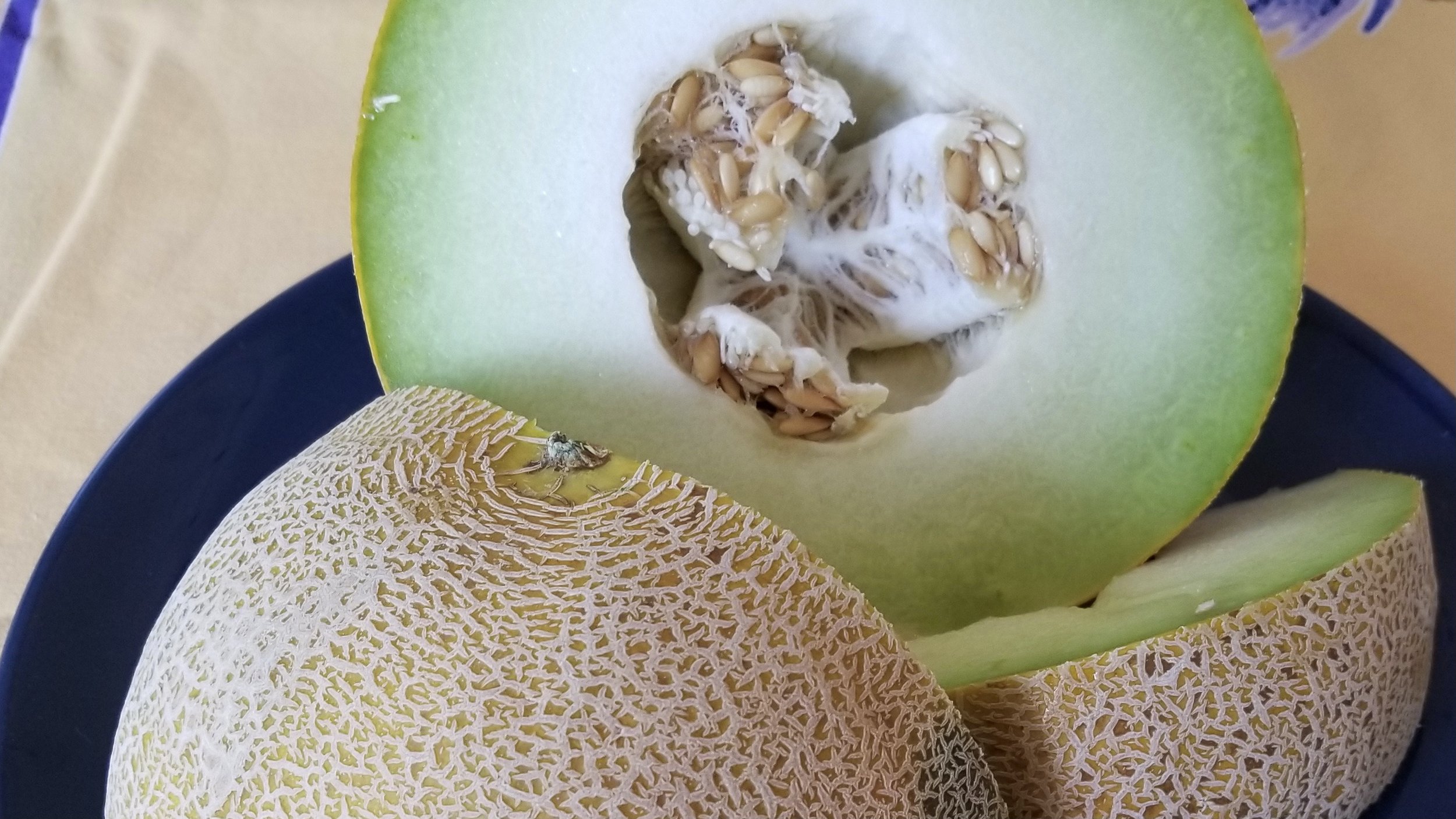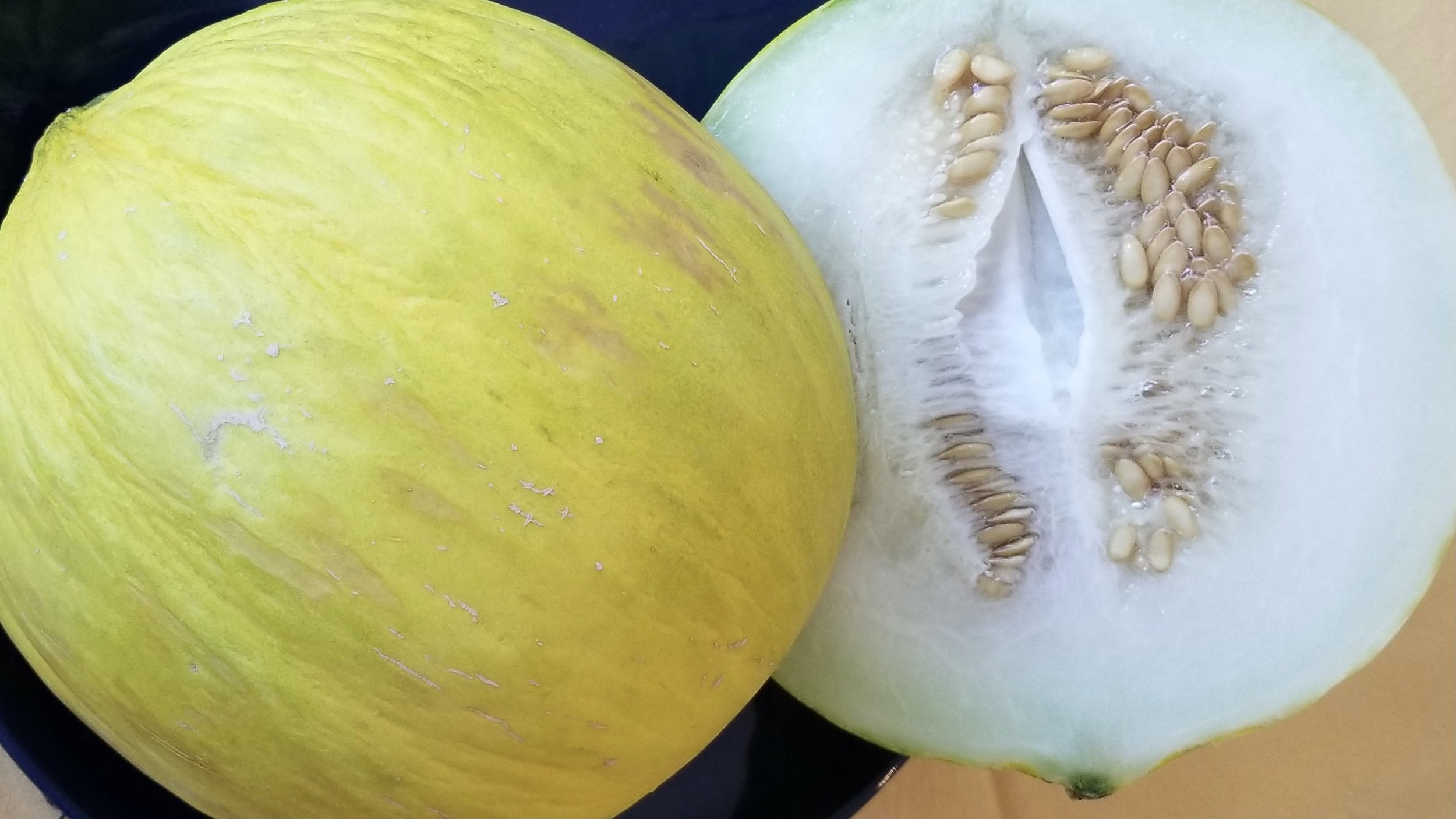COOKING WITH MELON
The Galia melon looks like a cantaloupe on the inside and a honeydew on the inside—and tastes like a cross of the two as well.
Quit thumping and start sniffing.
A healthy full-on palm-twunk may tell you something about that watermelon you’re eyeing, but a simple look at its skin is a better bet. And feeling up a cantaloupe is OK, but not as good a sign as giving it a good sniff.
Using your senses of sight and smell when shopping for melons gives you more information (and is better for the melon and its next customer) than the inherited “wisdom” of the twack.
On a watermelon, for example, see if it sports a golden or gold-white spot. That’s where it lay on the ground. If the spot is still merely blazingly white (or worse, if there’s no spot at all), that’s a sign that the melon was picked too early. It should feel heavy in the hand, of course, full of juicy water. But the spot is telltale.
And likewise for many other melons, such as the very familiar cantaloupe and honeydew. That is, don’t feel for “give”; that may bruise the melon more than do anything helpful for your kitchen.
Better to give either or both the stem and blossom end a good sniff. Plus, it’s such a beautiful sensory experience, why pass it up? If the melon gives off its perfume, it’s ripe, whether it feels soft to the touch or not. (Some melons remain firm even when ready-to-eat.)
In general, melons are fruits that do not ripen much after being picked, unlike, say, bananas or pears. And anything truly awful about the melon (a bruised spot, mushy skin, or scarring) is quite apparent to the eye.
A raft of different melons is available nowadays, well beyond the tried-and-true cantaloupe or honeydew. Their names, as well as their tastes, are exotic: Casaba, Galia, Hami, even Lemon Drop and Santa Claus (this latter because it is on offer at some grocers all the way into wintertime).
And melon meat can make the rounds in the kitchen well beyond its place in fruit cups, salads, or as the spine of a prosciutto-wrapped appetizer.
Notably fragrant, in or out of its skin, the Casaba melon’s white-green flesh tastes like a very sweet cucumber.
Ever tried roasted melon? Truly heaven on the tongue and a delicious topping for a bowl of yogurt, cereal (hot or cold), or ice cream: Heat the oven to 425 degrees. Line a baking sheet with parchment paper. Toss large pieces of skinned, seeded, just-ripe melon in 2-3 tablespoons brown sugar, and roast for 20-25 minutes until the melon pieces begin to caramelize at their edges. (Using larger pieces, you can do something similar on the grill.)
And here’s how to slice up those pesky melons, round as they generally are and given to rolling around the cutting board. Cut off both ends just a bit, making flat surfaces at both poles. Then, stood on one flat end to steady it, slice down from the opposite pole, following your melon’s shape, removing its pelt along the line that you’ll easily see between its ripe colored flesh and the whitish “pith.”
Of course, melon balls and chunks make for refreshing salads or toppings for greens, especially with sweet-sour dressings. And no disputing their popularity in smoothies, lassi drinks, or in summer soups.
But melon is also a fun sub for tomato in pico de gallo (or as a base for many another salsa for grilled fish, chicken or pork); as a foil to raw fish poke cubes; as the starter for a range of colorful aguas frescas; as a frozen confection, either alone or in a mix with cream; and served with certain salty cheeses such as feta or chèvre.
The inner section of the rinds, shorn of the outer skin, can be pickled or preserved. And keep in mind that the two herbs that marry perfectly with most any type of sweet melon are mint and basil. Use with abandon.
The peach-colored flesh of the Crenshaw melon sits under green- and yellow-flecked skin.
RECIPE: Broiled Melon with Balsamic
The recipe here is from the prolific Mark Bittman and first appeared in the New York Times Cooking section, September 17, 2013. Serves 4.
Ingredients
1 cantaloupe or honeydew melon, cut into 1-inch-thick slices, rinds and seeds removed
4 teaspoons vegetable oil
1/2 teaspoon salt
1/2 cup chopped pine nuts
Black pepper
2 tablespoons balsamic vinegar
Directions
Turn on the broiler; heat should be medium-high and rack no closer than 4 inches from heat source. Brush melon all over with oil and put on a rimmed baking sheet. Broil until beginning to color, 3-8 minutes depending on your broiler.
Turn melon carefully (or skip it if the melon seems too tender to turn), sprinkle with salt. Broil until melon is fully tender, another 2 or 3 minutes; sprinkle with nuts and pass under broiler again until pieces just begin to toast, no more than 1 minute. Sprinkle with lots of black pepper and drizzle with balsamic. Serve warm or at room temperature.


